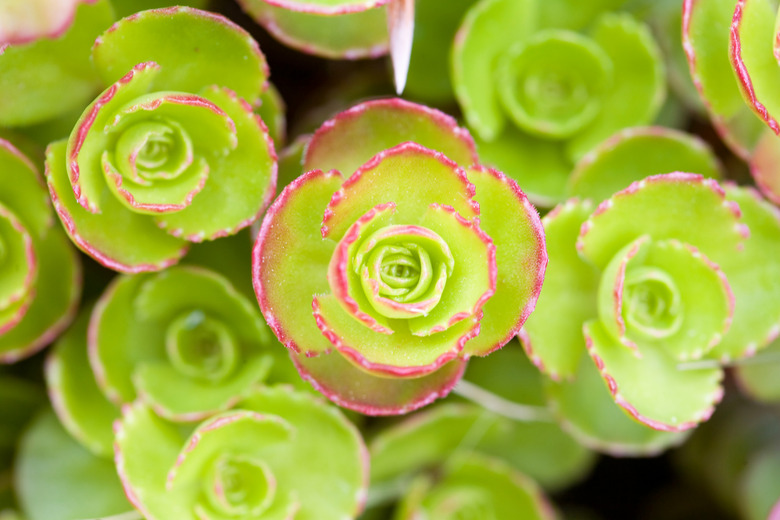When To Plant Sedum Dragon's Blood
If you have a sunny spot that you'd like to fill with tough but colorful plants, don't overlook a succulent called "Dragon's Blood" sedum (Sedum spurium "Dragon's Blood"). Also known as a stonecrop, this plant does well in average to poor soil and can thrive when weather is hot and dry. Easy to plant and maintain, planting time for "Dragon's Blood" sedum depends to some extent on the climate where you live.
Step 1
"Dragon's Blood" sedum has succulent, purple-green leaves which turn red in fall. It grows outdoors year round in U.S. Department of Agriculture plant hardiness zones 4 through 9, where it's usually an evergreen plant, except in the coldest parts of its range. If you live where winter temperatures drop below freezing for long periods, the best time to plant "Dragon's Blood" is in spring, after danger of frost has passed and plants are poised to put out new growth. You can also plant a new sedum in summer, provided you keep it well-watered during hot weather until it's established. Fall planting can also work well in cold-winter areas, but start four to six weeks before your last frost, so that plants can put out new roots before winter arrives.
In Warmer Areas
Step 1
"Dragon's Blood" sedum can continue growing year-round in areas where winter frost is rare; in addition to other times of year, you can also plant during winter in these areas, especially if you choose a warm spot, such as near a building wall. Because this variety is only 3 to 6 inches tall and spreads rapidly to a width of about 2 feet, siting it near the top of a stone retaining wall allows it to cascade downwards; this also helps keep it warm as it starts growing during the winter. **You can help a sedum get off to a good start by mulching it with 3 or 4 inches of straw or another organic mulch such as shredded bark.** This is especially helpful if you plant in winter, because mulch helps keep roots warm during cool weather, promoting quick growth of a new root system.
Step 2
- "Dragon's Blood" sedum has succulent, purple-green leaves which turn red in fall.
- It grows outdoors year round in U.S. Department of Agriculture plant hardiness zones 4 through 9, where it's usually an evergreen plant, except in the coldest parts of its range.
- You can also plant a new sedum in summer, provided you keep it well-watered** during hot weather until it's established.
Spacing and Early Care
Step 1
"Dragon's Blood" sedum prefers sandy or gravel-rich soil and requires excellent drainage to do well. If your soil is rich in clay and drains slowly, mix about 2 inches of coarse sand into the area at planting to improve its drainage. When planting several sedums, space them about 1 foot apart if you're using them as ground cover; space a single plant 1 1/2 to 2 feet away from other plants, to allow it to spread fully. Place each sedum plant in a hole that keeps it at the same level as in its pot, tamping soil down well. Water the plants thoroughly, soaking the soil around each plant to ensure no air is trapped around the roots. For the first few weeks, water the new plant whenever the top few inches of soil feels dry to the touch. Once established, the plant is very drought tolerant and only needs occasional extra water.
Step 2
- "Dragon's Blood" sedum prefers sandy or gravel-rich soil and requires excellent drainage to do well.
- If your soil is rich in clay and drains slowly, mix about 2 inches of coarse sand into the area at planting to improve its drainage.
Continuing Care
Step 1
"Dragon's Blood" sedum spreads rapidly after planting, but if you're using it as a ground cover, it helps to keep the areas between plants well-weeded to minimize competition for moisture and soil nutrients. You can also help the plant off to a good start by feeding it every four to six weeks during the first season. Use a general-purpose fertilizer such as a 10-10-10 formula, diluting it at a rate of 1/4 teaspoon per gallon of water, but also check your product label for additional directions.
